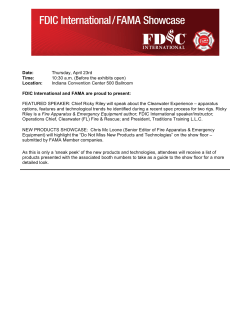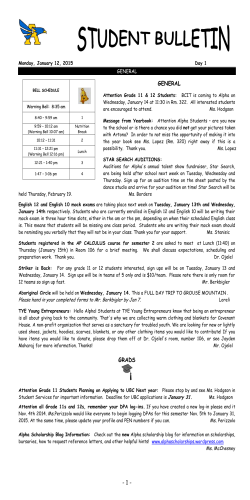
Measuring alpha: The consequences of ignoring the four
Intern. J. of Research in Marketing 26 (2009) 164–165 Contents lists available at ScienceDirect Intern. J. of Research in Marketing j o u r n a l h o m e p a g e : w w w. e l s ev i e r. c o m / l o c a t e / i j r e s m a r Measuring alpha: The consequences of ignoring the four-factor model In response to the commentary: "The statistical significance of portfolio returns" by Claes Fornell, Sunil Mithas and Forrest Morgeson Don O'Sullivan a ,⁎, Mark C. Hutchinson b ,c, Vincent O'Connell d a Melbourne Business School, University of Melbourne, Australia Department of Accounting, Finance and Information Systems, University College Cork, College Road, Cork, Ireland c Centre for Investment Research, University College Cork, College Road, Cork, Ireland d Korea University Business School, Korea University, Anam Dong, Seongbuk-Gu, Seoul 136-701, Republic of Korea b To begin, we complement Fornell, Mithas, Morgeson, and Krishnan (2006) for raising important issues with respect to the relationship between customer satisfaction and stock prices. Fornell et al. (2006) present evidence of a new anomaly in efficient market theory, specifically the theory that portfolios formed from firms with high levels of customer satisfaction generate consistently abnormal returns — high returns at low risk. While we disagree with the conclusion that their ACSI-based trading strategies lead to abnormal stock returns, we strongly believe that customer satisfaction is an important determinant of firm value — one that firm executives ignore at their peril. Our paper demonstrates that the ACSI-based trading strategy proposed by Fornell et al. (2006) does not offer abnormal returns when taking into account the following four factors: market risk, book-tomarket ratio, firm size, and momentum. Starting with the pioneering work of Sharpe (1964) and Lintner (1965), and continuing with Fama and French (1993) and Carhart (1997), contemporary finance theory has evolved to the point where the four-factor model is the conventionally accepted benchmark for judging whether returns are abnormal. Our analysis demonstrates that the abnormal returns documented in Fornell et al. (2006) evaporate when the aforementioned four factors are properly accounted for. We now turn our attention to some of the specific comments offered by Fornell, Mithas, and Morgeson (2009-this issue). Fornell et al. (2009-this issue) note that our findings point to “a cumulative return of 164% vs. 98% for the market (S&P 500), corresponding to above-market annualized returns of +3.8%. To put this in perspective, less than 10% of actively managed portfolios generate even a positive alpha, let alone returns as high as 3% per year (Barras, Scaillet, & Wermers, 2008).” As Barras et al. (2008) do not report the abovemarket annualized returns of their sample, it is not possible to directly compare the above-market annualized returns of + 3.0% with their results. However, as in our study, Barras et al. (2008) provide estimates of alpha (also using a four-factor model specification) to measure performance. They find that over 75% of funds deliver zero alpha, just as we find that a portfolio formed following Fornell et al. (2006) ⁎ Corresponding author. Tel.: +61 3 9349 8223. E-mail address: d.o'sullivan@mbs.edu (D. O'Sullivan). generates zero alpha; this demonstrates the difficulties faced even by professional stock pickers when generating statistically significant performance. Barras et al. (2008) further demonstrate that even in cases where positive alpha is discovered for a fund, it is often due to chance and should be treated with caution. Fornell et al. (2009-this issue) raise interesting questions about the adequacy of the four-factor model used in our analysis, noting that “Under the market efficiency hypothesis, the predictor variables in these models are interpreted as risk factors and a positive and significant intercept (alpha) as indicative of abnormal returns. Under the same hypothesis, the predictor variables must completely account for the returns. For example, Fama and French (1996) report R2s close to 1.0.” In Fama and French (1996) the authors report R2, whereas our study reports adjusted R2, which accounts for the incremental explanatory power of individual variables. These adjusted R2 values (ranging from 0.62 to 0.88) are in line with recent studies in both marketing (e.g., Aksoy, Cooil, Groening, Keiningham, & Yalcin, 2008) and finance (e.g., Sadka, 2006). Fornell et al. (2009-this issue) make the observation that “Rather than subjecting the returns to an analysis model that assumes market efficiency, it may make more sense to simply ask what the probability would be that returns of 164% vs. 98% ( a difference of 66%) over a 10year period is due to chance.” In addressing this question, we note that the ACSI survey focuses primarily on large firms. Firm size is a well known driver of stock returns. Thus, a more appropriate question in the present context is — What is the probability that the returns from a trading strategy based on ACSI outperform those of a trading strategy based on a random selection of stocks of equivalent firm size? Obviously, this question can be easily extended to other factors (i.e., momentum and book-to-market). We agree with Fornell et al. (2009-this issue) that “Back testing can only get us so far. It always has an element of capitalizing on chance. Real data and real portfolios would be better.” Real world applications are the acid test of the Fornell et al. (2006) findings. In that spirit, let us temporarily set aside the debate with respect to the four-factor model that is discussed earlier. Apart from any theoretical considerations, our paper highlights two issues that are important in the real world of investment: transaction costs and the Sharpe ratio. Real world rebalancing requires significant transaction costs, and any serious claim of 0167-8116/$ – see front matter. Crown Copyright © 2009 Published by Elsevier B.V. All rights reserved. doi:10.1016/j.ijresmar.2009.03.003 D. O'Sullivan et al. / Intern. J. of Research in Marketing 26 (2009) 164–165 inefficiency must take these costs into account. For example, Bernard and Thomas (1990) show that the well-known post-earningsannouncement drift anomaly is robust to transaction and other trading costs. Is this the case with the proposed ACSI-based anomaly? Equally, consider the Sharpe ratio, a widely used ‘rule of thumb’ measurement that relates excess return to portfolio standard deviation. The Sharpe ratio of Portfolio 1 in our Table 2 is 0.27, which is barely higher than the 0.24 for Portfolio 3 in the same table. The mean annual Sharpe ratio in the U.S. between 1970 and 2000 was 0.44 (as reported in Shackman, 2006). Based on this perspective and the results of the four-factor model, we believe that significantly more proof is needed before the proposed ACSI-based anomaly can be accepted. References Aksoy, L., Cooil, B., Groening, C., Keiningham, T. L., & Yalcin, A. (2008). The long term stock market valuation of customer satisfaction. Journal of Marketing, 72(4), 105−122. Barras, L., Scaillet, O., & Wermers, R. (2008). False discoveries in mutual fund performance: Measuring luck in estimated alphas. available at http://papers. ssrn.com/sol3/papers.cfm?abstract_id=869748. Working Paper College Park: Robert H. Smith School of Business. 165 Bernard, V., & Thomas, J. (1990). Evidence that stock prices do not fully reflect the implications of current earnings for future earnings. Journal of Accounting and Economics, 13(4), 305−340. Carhart, M. M. (1997). On persistence in mutual fund performance. Journal of Finance, 52(1), 56−82. Fama, E. F., & French, K. R. (1993). Common risk factors in the returns on stocks and bonds. Journal of Financial Economics, 33(1), 3−56. Fama, E. F., & French, K. R. (1996). Multifactor explanations of asset pricing anomalies. The Journal of Finance, 51(1), 55−84. Fornell, C., Mithas, S., & Morgeson, F. V. (2009). The Statistical Significance of Portfolio Returns. International Journal of Research in Marketing, 26(2), 180−181 (this issue). Fornell, C., Mithas, S., Morgeson, F. V., & Krishnan, M. S. (2006). Customer satisfaction and stock prices: High returns, low risk. Journal of Marketing, 70(1), 3−14. Lintner, J. (1965). The valuation of risk assets and the selection of risky investments in stock portfolios and capital budgets. Review of Economics and Statistics, 47(1), 13−37. Sadka, R. (2006). Momentum and post-earnings-announcement drift anomalies: The role of liquidity risk. Journal of Financial Economics, 80(2), 309−349. Shackman, J. D. (2006). The equity premium and market integration: Evidence from international data. Journal of International Financial Markets, Institutions and Money, 16(2), 155−179. Sharpe, W. F. (1964). Capital asset prices: A theory of market equilibrium under conditions of risk. Journal of Finance, 19(3), 425−442.
© Copyright 2025









